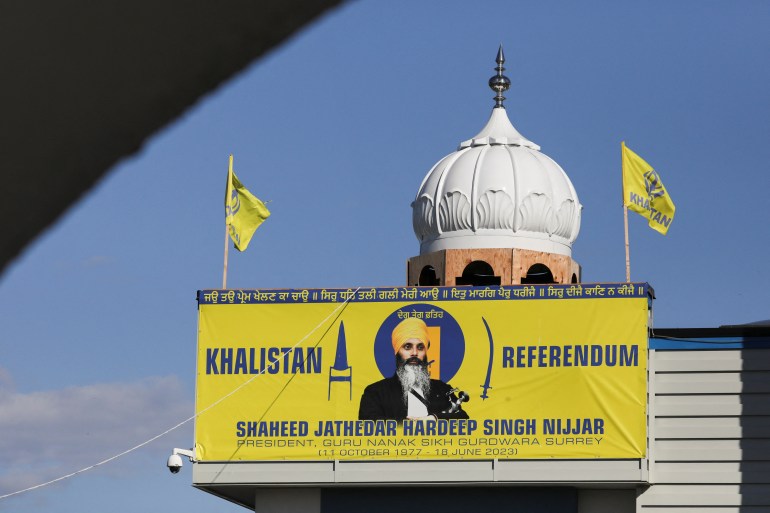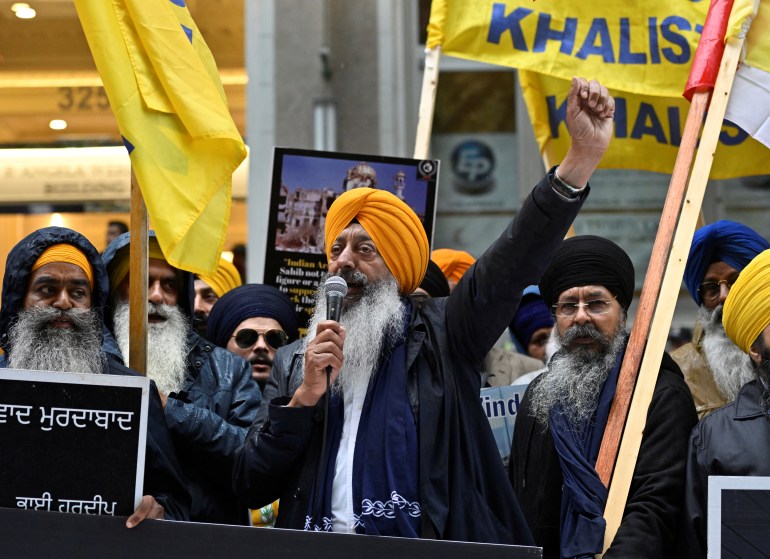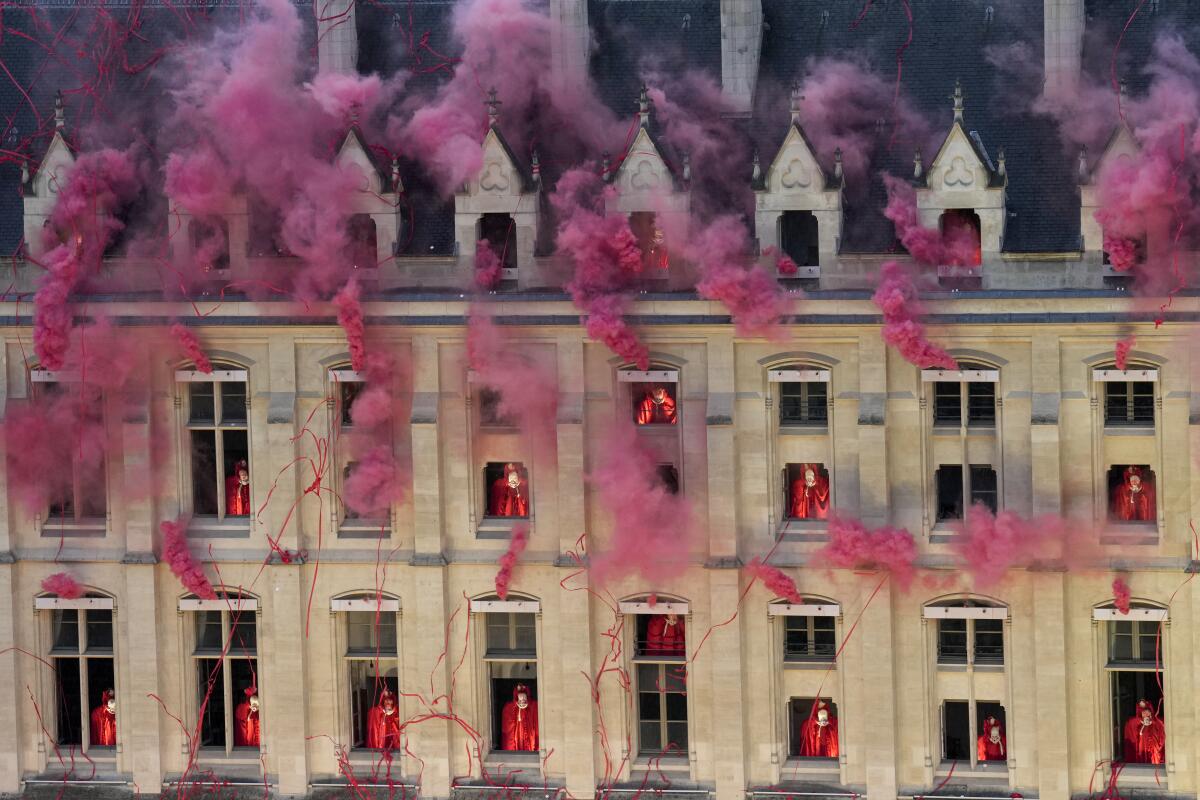Surrey, British Columbia – On a Saturday afternoon in a Sikh temple in Surrey, Canada, boys and men with determined faces wield swords and sticks at each other in an ancient martial art called gatka.
“We are a rebellious community,” Gurkeerat Singh, a farmer, electrician, photographer and spokesperson for the Guru Nanak Sikh Gurdwara Temple, tells me. Surrey is about a 45-minute train ride outside of Vancouver. The city of half a million people is home to the second-largest Sikh population in the country.
Today, as the first snow of the season melts in puddles outside the building, there’s a small but encouraging crowd watching the gatka tournament inside. “From a young age, we teach our children to be armed and learn how to defend themselves,” says Gurkeerat.
That need for the community to defend itself no longer feels like a hypothetical scenario in this fast-paced suburban city, which has the slogan: “The future lives here”. Not since the assassination of Sikh separatist Hardeep Singh Nijjar in Surrey in June.
“The game has completely changed,” says 42-year-old Moninder Singh, a spokesperson for the British Columbia Gurdwaras Council.
“Now, it’s no longer, you live to fight another day but you don’t know if you’ll live, the way they’re operating. Hardeep’s assassination, although not a surprise, was still unprecedented.”
“They” refers to the Indian government and “you” to the Sikh community in Surrey, which is at the eye of a major diplomatic and political storm that has engulfed relations between Ottawa and New Delhi relations.
Nijjar, the Guru Nanak Sikh Gurudwara president who came to Canada as a refugee in 1997 from Punjab in northwest India, was driving out of the temple’s parking lot in his pick-up when he was shot dead by two masked assailants on June 18 – Father’s Day.
Many in the community believe the killers were local gangsters, hired by the Indian state. They felt vindicated when Canadian Prime Minister Justin Trudeau announced to Parliament in September that there was credible evidence that India had a hand in the killing of Nijjar.
It set off a diplomatic war: Each country expelled diplomats from the other, trade talks stalled and even visa services were temporarily affected.
At the heart of the accusation against India lies its effort to crush a separatist Sikh movement that Nijjar advocated for vocally. For the past four decades, many Sikhs in communities around the world have been demanding that an independent Sikh state, known as Khalistan, be carved out for them in Punjab.
India designated Nijjar and other pro-Khalistan leaders of the Sikh diaspora, such as New York-based Gurpatwant Singh Pannun, as “terrorists” – a charge they and their supporters deny.
And in November, federal prosecutors in the United States indicted an Indian hitman on charges of working with Indian government intelligence in a bid to kill Pannun, lending further credence to concerns that New Delhi was deploying kill squads for targeted assassinations abroad.
The Indian government has insisted that such acts are not a part of its policy and said it is investigating the US allegations regarding the plot against Pannun.
Six months after the murder of 45-year-old Nijjar, a married plumber and father of two, several Sikh leaders in Surrey say they have received threats on social media. Some have been alerted to threats by Canadian officials.
But many in the community say that whatever happens, they will not be silenced or defeated.

‘Blown up in their face’
Today, Surrey is home to about 154,000 followers of the Sikh faith, 170,000 Christians and about 30,000 Hindus. A hub for students, immigrants and others looking for cheaper housing, it is a city of shopping complexes, with many boasting Indian restaurants with names like Happy Singh Sweet Treats.
Further down the highway in Delta, a city that borders Surrey, there is a plaza called Little India. Unveiled as a cultural precinct for the South Asian community in 2016, it features boutiques like The Turban Villa, which sells stitched turbans and accessories and provides services “for any type of turban tying for marriages, parties” as well as bridal shops such as Sleek Bazar. There are also insurance and immigration agents, fabric stores and chai sellers.
The area is a microcosm of the Sikh community’s growing stature in Canada’s public life. There are about 770,000 Sikhs in the country – the largest population outside of India – making up 2.1 percent of the population.
Many families moved to Canada in the 1980s amid a harsh crackdown by Indian security agencies in Punjab against perceived supporters of the Khalistan movement, which international rights groups condemned at the time. The Punjab police were accused by activists, and even the US Department of State, of carrying out extrajudicial killings.
In June 1984, the Indian Army raided the Golden Temple in the Punjab city of Amritsar with tanks to drive out armed separatists, killing hundreds of people, including pilgrims. Four months later, then-Indian Prime Minister Indira Gandhi was killed by two of her bodyguards. An anti-Sikh massacre followed in the streets of New Delhi and other parts of the country. Thousands of Sikhs were killed.
Today, many see shades of a repeat of those attacks on Sikhs by Indian authorities – only this time, in Canada.
“They’re very desperate right now to shut us out – and they’re willing to kill for it,” says Moninder, whose parents were born in India. “But it’s kind of blown up in their face. That’s the same tactic they used in Punjab, where they would kill and strike fear into villages and families … ‘Your child is next.’
“It didn’t really have the intended effect and I think that was apparent a week after Hardeep’s assassination, when about 30,000 people marched his coffin through the streets. I’ve never seen something like that before.”
Moninder is still grieving the loss of a “brother”.
He describes his comradeship with Nijjar as the pairing of an odd couple. “I’m born and raised here,” says Singh. “He’s born and raised in Punjab. He grew up in a family that was fighting in the movement, was tortured by the police while he was a teenager… He fled the country because people around him started to disappear while he was in college. Me, I went to elementary school, high school, university, everything here.”
What bound them together, in about 2006, was the struggle for Khalistan.
The movement has always ebbed and flowed, depending on events in Punjab and how much traction the diaspora can achieve, says Moninder. After what he calls the “peak violence” of the 1980s and 1990s, there was a period of quiet when the community endured what he says was a collective post-traumatic syndrome disorder (PTSD) before they realised that they needed to regroup.
“For the last decade, we’ve been growing in strength,” says Moninder. “We were vocal then. But now being vocal has landed a lot differently, especially in the social media age. We’re able to get into people’s homes faster. It’s easier. There’s more channels to do so.
“India is having a hard time dealing with us now.”
![[Amy Fallon/Al Jazeera]](https://www.aljazeera.com/wp-content/uploads/2023/12/Photo-3-12-2023-2-24-59-pm-1703375472.jpg?w=770&resize=770%2C578)
‘They can kill us’
At a bus stop not far from the temple, Amrita Sidhu, 68, a housewife who came to Canada in 1998 from India with her husband, tells me in limited English that Nijjar was “not bad”.
“He did good work. He made [the] building very good. You see that building before, he made another building over that side,” she says pointing to the temple. “I don’t know what happened in India. In India, maybe he has a criminal record. Here, he did good work. He comes to the temple, he helps people.”
When asked if she thinks there will be another murder, she says, “I don’t know yet.”
Further down the highway, opposite an insurance business, a group of young men wearing turbans stand near cars, passing a cigarette around. “Everybody’s busy shopping, getting on with their lives,” one of them says with a shrug when I ask how they feel. “Nobody gives a s***. It happens.”
But many in the community do care.
Around the same time as Nijjar’s assassination, Sikh activist Avtar Singh Khanda died suddenly in Birmingham in the United Kingdom, sparking questions from his family and friends. Months earlier, Khanda had voiced concerns that Indian police had verbally harassed him via phone and threatened his family in Punjab.
Members of the Guru Nanak Sikh Gurdwara are adamant the Indian government was behind Khanda’s death, too. The circumstances are “highly suspicious”, says Gurpreet Kaur Rai, British Columbia’s president of the World Sikh Organization of Canada and a lawyer. “Although the UK government hasn’t come out to say that the Indian government was behind that, we know that it was.”
Closer to home, at least three Surrey Sikhs – those who have come forward publicly – have received a “duty to warn” notice from the Royal Canadian Mounted Police (RCMP) and the Integrated National Security Enforcement Team (INSET) that their lives were in danger. The notices did not contain specific details.
Gurmeet Singh Toor, a senior member of the Guru Nanak Sikh Gurdwara, who was close to Nijjar, received one of the notices. For security reasons, Toor has sent his 11-year-old daughter to stay with his brother-in-law. When she will return, he says, “depends on the Canadian government and police”.
“I plead to the Canadian police if they [can] capture anybody who’s giving us [a] threat,” he says. “Otherwise they can kill us.”
Other Sikh leaders in the community, such as the gurdwara’s Gurkeerat Singh and Jasveer Singh, a senior press officer with the global Sikh Press Association, regularly receive threats on social media, they say.
The community also faces another India-related threat, say its leaders.
In Surrey and nearby Abbotsford, groups purportedly linked to Indian gangster Lawrence Bishnoi are threatening business owners, demanding ransoms from them. Bishnoi’s gang has previously claimed a role in the killings of pro-Khalistani activists in Canada.
Jasveer Singh describes it as a “different element of Indian nationalist thuggery”, claiming that the Punjabi Sikh community is being “terrorised” economically, too.
Behind the threats, there is “a lot of jealousy about the Sikh diaspora” in Surrey, he says. “You can probably see it yourself. We’ve done very successfully,” he says. The country has 18 Sikh members of Parliament and there are many Sikh businesses, he notes.
“We’ve held onto our heritage. We’re freedom fighters. We’ve held onto that … There’s a resentment that we’re newer migrants.” The gangs think that the community is against India and that “we don’t deserve what we have”, he adds.
‘Chardi kala’
But Kaur Rai says the community is drawing strength from its faith. “There’s a concept called ‘chardi kala’, which translates into ‘rising spirits’. So, we always try to stay and remain in chardi kala, even when times are tough.”
Kaur Rai, 25, herself grew up going to the Guru Nanak Sikh Gurdwara to pray and volunteer. “We’ve always known that there’s these issues with the Indian state and Sikhs,” she tells Al Jazeera while sitting in her car, just metres from where Nijjar was gunned down. Yet, the community, she says, remains undeterred from its beliefs.
In the dining hall on the same level of the two-storey temple, a free lunch is being served. We can see followers sitting cross-legged on a mat on the floor, eating among the sounds of kirtan (chanting), drums, chattering and the clanging of cutlery.
The diners today include Ajaib Singh Bagri, who was co-acquitted in 2005 of mass murder and conspiracy charges over two Air India bombings in 1985 that killed 331 people.
“I think historically, maybe a few years ago, the people in the community and parents didn’t want to talk about Khalistan or even say the word because we were conditioned by the Indian state that it was a bad word to say,” says Kaur Rai.
But in the past few years this has changed, she says.
“Hardeep’s death has been a watershed moment for Surrey, and all Sikhs around the world. People are coming to terms with the fact that everybody has the right to support and advocate for what they believe in and there’s nothing wrong with talking about or advocating for Khalistan.”

‘Unprecedented times’
That confidence within the community did not come easily.
“It took a long time,” says Moninder, of the British Columbia Gurudwara Council. “But India has nowhere to run now the truth is out for the entire world that India is running these types of operations across the world. They’re undermining the sovereignty of countries like Canada, the United States, the UK.”
Still, India is not the only one that has questions to answer. Given the current threat, many in the community now want to know how their government in Canada is going to keep them safe.
“We don’t think it’s enough for you to just inform somebody and say, ‘Look, you know there’s a threat to your life, be safe’,” says Kaur Rai. “This murder has fuelled a fire in the community to hold those that are responsible accountable and ask for accountability, whether that be from the Canadian government or elsewhere.”
Nijjar’s image is everywhere in the Guru Nanak Sikh Gurdwara. Most prominently, he is featured on a poster for an unofficial Khalistan global referendum campaign that sits high up on the front of the temple. Previous rounds of voting were held here in September and October. More are slated for the US. The referendum, primarily targeting the diaspora, asks Sikhs whether they want a separate nation carved out of India.
Nijjar is also on the wall of the hall where a placard declares that he was the “first Khalistani leader in Canada to attain martyrdom”. It reads that he was “assassinated by the Indian government”. And he’s on a 2024 calendar currently being given out to community members.
“We feel his spirit gives us energy,” says Gurkeerat Singh. “He was a short individual. But when he walked into the room, he was the tallest man in the room.”
Unlike community veterans who endured the turbulence of the 1980s, younger members are still grappling with what the implications of Nijjar’s assassination are for them.
Jasveer, of the Sikh Press Association, was born in 1986, two years after the Golden Temple was invaded. He remembers watching a film with his mother about the 1980s and how she started crying, reminded of the fear that had enveloped Punjab then.
Now, he says, he understands better what his community elders went through.
“It’s one thing to hear about it … and being hated by the Indian government and the nationalists that don’t want Punjab to be free is one thing,” he says. “But to see it take this form … we’re in unprecedented times for our generation.”




